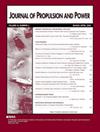Combined Cycle Nuclear System Architecture for Crewed Mars Spacecraft Propulsion and Power
IF 2.4
4区 工程技术
Q2 ENGINEERING, AEROSPACE
引用次数: 0
Abstract
Nuclear thermal propulsion can potentially reduce the time of flight and spacecraft system mass needed for human spaceflight beyond cislunar space. This nuclear propulsion system has comparable thrust capability to chemically impulsive systems, which at about twice the specific impulse, can double the delta-velocity ([Formula: see text]) for the same propellant mass. However, the canonical problem for nuclear propulsion has always been that its benefits are shadowed by low technology readiness of a complex system. This paper describes a combined cycle nuclear thermal rocket (CCNTR) system architecture for propulsion and electrical power that comprises a 42-MWt-capable nuclear reactor core to provide 9.4 kN thrust on demand at a specific impulse of 940 s. The liquid hydrogen propellant flow through the rocket chamber cools the reactor during burns, thereby producing thrust while concurrently rejecting waste heat to space. The reactor also produces up to 100 kWe power for the spacecraft, eliminating the need for solar power generation and averting challenges associated with restarting a cold reactor for propulsive burns. Radiators reject the waste heat from electrical power production. Earth-to-Mars orbital transfers less than 100 days appear feasible assuming 680,000 kg of liquid hydrogen propellant and a vehicle dry mass of 83,000 kg that includes the 13,000 kg CCNTR system. Together, these results suggest that a CCNTR could be most promising to enable crewed missions to Mars.载人火星航天器推进与动力联合循环核系统结构
核热推进可以潜在地减少人类在地月空间以外的空间飞行所需的飞行时间和航天器系统质量。这种核推进系统的推力能力与化学脉冲系统相当,化学脉冲系统的比冲是化学脉冲系统的两倍,在相同的推进剂质量下,δ速度可以是化学脉冲系统的两倍。然而,核动力推进的典型问题一直是它的好处被复杂系统的低技术准备程度所掩盖。本文介绍了一种用于推进和电力的联合循环核热火箭(CCNTR)系统架构,该系统包括一个42兆瓦特的核反应堆堆芯,可按需提供9.4 kN推力,比冲为940秒。在燃烧过程中,液氢推进剂流经火箭室冷却反应堆,从而产生推力,同时将废热排除到太空中。该反应堆还为航天器提供高达100千瓦时的电力,消除了对太阳能发电的需求,并避免了与重新启动推进燃烧的冷反应堆相关的挑战。散热器排除了电力生产产生的废热。假设68万公斤的液氢推进剂和8.3万公斤的干质量(包括1.3万公斤的CCNTR系统),地球到火星的轨道转移在100天内是可行的。总之,这些结果表明,CCNTR可能最有希望实现载人火星任务。
本文章由计算机程序翻译,如有差异,请以英文原文为准。
求助全文
约1分钟内获得全文
求助全文
来源期刊

Journal of Propulsion and Power
工程技术-工程:宇航
CiteScore
4.20
自引率
21.10%
发文量
97
审稿时长
6.5 months
期刊介绍:
This Journal is devoted to the advancement of the science and technology of aerospace propulsion and power through the dissemination of original archival papers contributing to advancements in airbreathing, electric, and advanced propulsion; solid and liquid rockets; fuels and propellants; power generation and conversion for aerospace vehicles; and the application of aerospace science and technology to terrestrial energy devices and systems. It is intended to provide readers of the Journal, with primary interests in propulsion and power, access to papers spanning the range from research through development to applications. Papers in these disciplines and the sciences of combustion, fluid mechanics, and solid mechanics as directly related to propulsion and power are solicited.
 求助内容:
求助内容: 应助结果提醒方式:
应助结果提醒方式:


